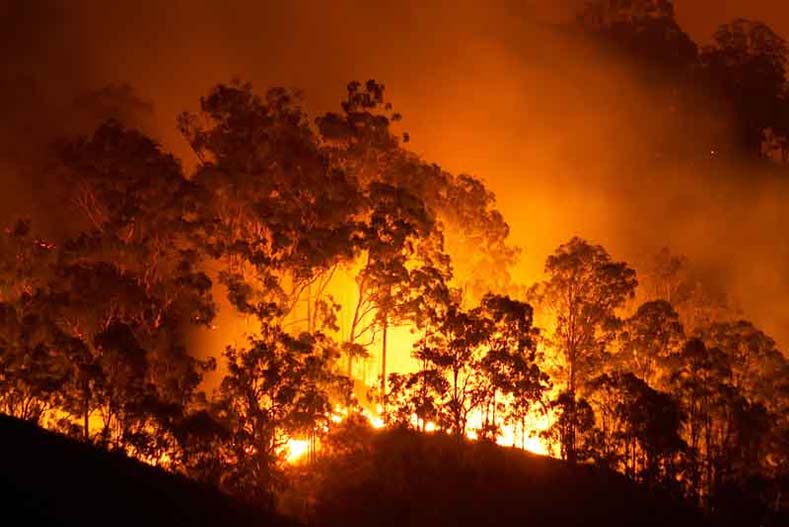
AKC is a participant in affiliate advertising programs designed to provide a means for sites to earn advertising fees by advertising and linking to akc.org. If you purchase a product through this article, we may receive a portion of the sale.
When wildfires ravage an area, both humans and pets are at risk of being displaced and inhaling dangerous amounts of smoke. Remember — if you feel the effects of smoke, your pets probably do, too. And if you ever have to evacuate your home, your pets should always go with you.
If you’re in an area impacted by wildfires or smoke, don’t panic. Here’s how to prepare for an emergency, protect your pup from dangerous air quality, and evacuate safely.
What To Do With Your Pets When the Air Is Smoky
During wildfires, the air quality is often dangerous and hazardous to breathe. Some experts estimate that breathing in smoke-filled air for a whole day can be equivalent to smoking about seven cigarettes per day — and that’s for a human! Brachycephalic breeds (such as Pugs and Bulldogs), puppies, and senior dogs may be especially at risk of inhaling too much smoke.
Here’s what to do if you experience poor air quality due to smoke:
- Keep your pets inside as much as possible, with your windows shut
- If your dog needs to go to the bathroom, only let them out for short periods of time
- Avoid long walks and activities outdoors
- Watch for signs of smoke inhalation (see below)
There are many ways to keep your pets busy and active while indoors!

Signs Your Pet May Have Inhaled Too Much Smoke
Call your veterinarian right away if your dog exhibits any of the following symptoms:
- Coughing
- Trouble breathing
- Wheezing or loud breathing
- Fatigue or disorientation
- Reduced appetite
- Reduced thirst
- Red eyes, excessive tearing or blinking, or pawing at eyes (indicate cornea trauma)
Do Face Masks Protect Dogs Against Smoke?
While most people have gotten used to wearing face masks to combat COVID-19, they can also be a tool for protecting humans against poor air quality. However, no evidence has been seen that masks protect against carbon monoxide, carbon dioxide, and cyanide, which are some of the most dangerous aspects of smoke inhalation. Not enough research has been done to support masks’ possible effectiveness with regards to protecting animals. The best plan is to keep both you and your pets indoors as much as possible.
Preparing Your Pets For Fire Evacuation
It’s important to remember that your pets are a part of your family, so if you have to evacuate, your animals should go with you. This is why you should have an evacuation plan ready before you even think you may need it.
Make sure your dog is microchipped. A microchip allows veterinarians and shelter workers to scan your pet and access your contact information. A microchip could prove an essential part of reuniting you with your dog if you get separated. Keep your dog’s microchip registration up to date with your most recent phone number and address.
But don’t forget the low-tech option, too. Your dog should be wearing a collar with up-to-date identification tags. Finally, have copies of all your dog’s important documents. Consider including:
- Vaccination certificates and most recent heartworm test results
- Information about any health concerns, medications, or behavior problems
- Contact information for your veterinarian
- Identification information including proof of ownership and a current photo of you with your dog (in case your dog gets lost)
Pack a Fire Evacuation Kit
A pet disaster preparedness kit should include everything your dog will need in an emergency evacuation. Consider your dog’s basic needs, safety, and any medical issues. Keep it in an easy-to-carry waterproof container and store it where you can easily get to it.

Your dog’s go-bag should include items such as:
- Bottled drinking water (during an emergency, tap water can be contaminated)
- Food in waterproof containers or cans. (Choose pop-top tins or pack a can opener.) Bring enough for at least two weeks.
- Food and water bowls
- Prescription medications and other required health supplies (such as flea and tick medication and heartworm preventative)
- Dog first-aid kit
- Poop bags and other clean-up supplies
- Familiar items like toys, bedding, and blankets to comfort your dog
- Stress-relieving items like an anxiety vest or calming sprays if your dog is prone to anxiety
How to Evacuate With a Dog
Always bring your pets with you when evacuating your home. Pack your pet’s emergency kit and documents and make sure you have a pet-friendly place to stay. Whether you’re staying with family, at a shelter, or a pet-friendly hotel, there are several options for traveling with your pets.
In the unfortunate event that you are separated from your pet or lose your pet, contact AKC Reunite. Above all, stay vigilant, stay indoors if you can, and call your veterinarian if you notice any changes in your dog.

